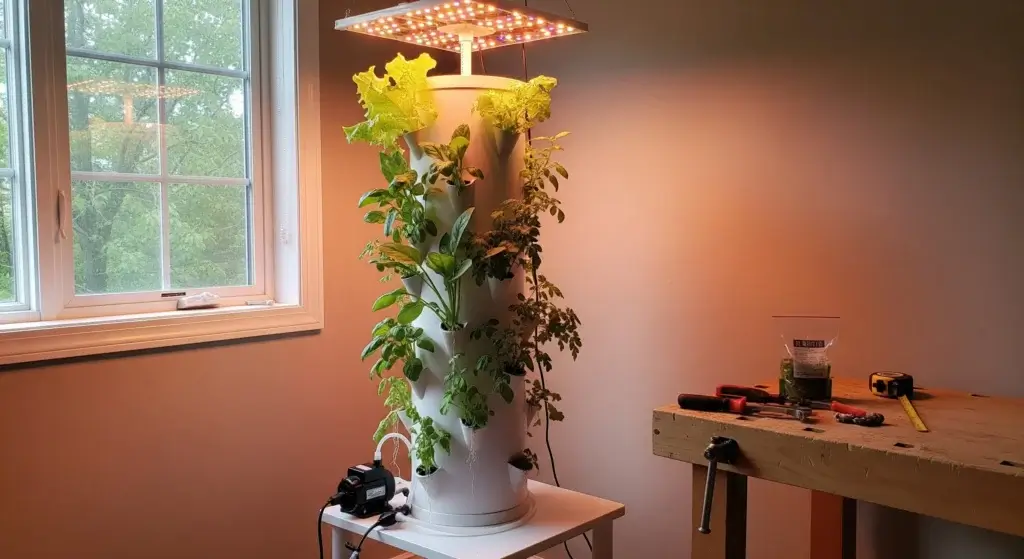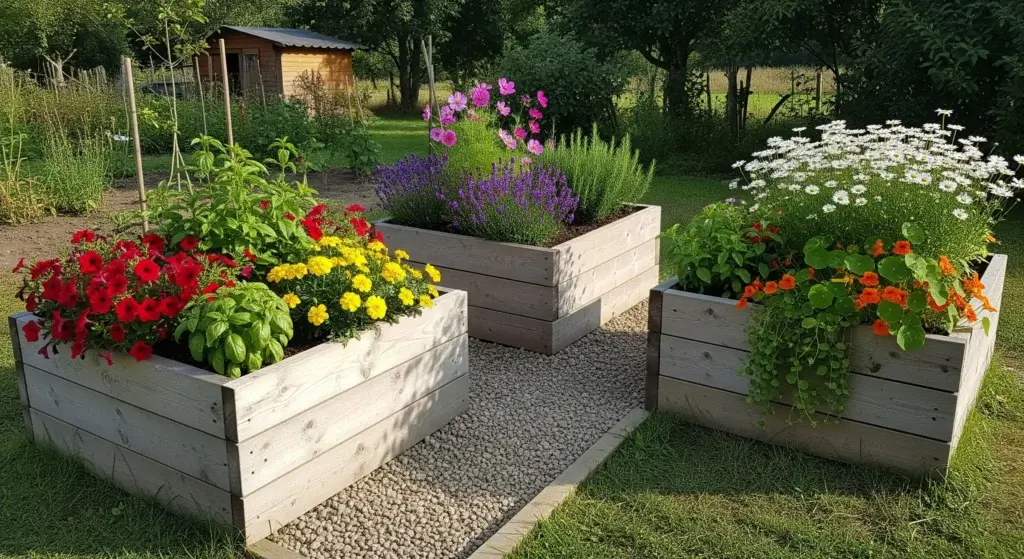
DIY plant pots are a fun and easy way to add personality and charm to your garden.
Whether you’re looking to create a unique planter for your patio or a whimsical container for your indoor plants, this guide will provide you with a variety of ideas and inspiration.
Here are some creative DIY plant pot ideas to get you started
Best Plant Pots Ideas
Hanging Planter Posts for String Lights

Elevate the ambiance of your garden or patio with the enchanting glow of hanging string lights.
Crafting your own planter posts designed to elegantly hold these lights not only adds a touch of magic but also integrates functionality into your outdoor lighting scheme.
- Read also: DIY Plant Stands Indoor for Every Style
- Read also: DIY Plant Hangers with Rope
Materials needed
Gather the following materials before embarking on this delightful DIY project:
- Large planter (at least 20″Wx15″H)
- Quickcrete
- 8ft cedar fence post
- 2 hanging plant brackets
- 2 L-brackets
- Drill
- Level
- Hanging wire
- Wire cutter
- String lights
Step-by-step guide
Step 1: Secure L-brackets to the fence post
Position the cedar fence post in the center of the planter.
Using a drill, attach two L-brackets flush with the bottom of the fence post.
Securely fasten the bottom of the L-brackets into the planter, ensuring a stable foundation.
Step 2: Mix and pour quickcrete
In a wheelbarrow or bucket, follow the instructions on the Quickcrete package to mix it with water.
Pour the Quickcrete around the fence post in the planter, filling it approximately 3/4th full.
Smooth the top surface to create a neat and even finish.
Step 3: Incorporate soil and plants
Once the Quickcrete has dried, introduce soil into the planter.
Add your chosen plants, ensuring they do not come into direct contact with the Quickcrete.
This step not only enhances the aesthetic appeal but also contributes to the functional aspect of your planter posts.
Recycled Plant Pots

Embrace sustainability and inject a creative spark into your garden with recycled plant pots.
This eco-friendly endeavor not only reduces waste but also adds a unique touch to your outdoor space.
Discover the joy of repurposing everyday items into charming plant containers.
Materials needed
Gather the following materials before delving into this eco-friendly project:
- Empty cans, bottles, or suitable household items
- Drill
- Small pebbles or gravel
- Potting soil
- Your favorite flowers or plants
Step-by-step guide
Step 1: Collect suitable containers
Begin by collecting empty cans, bottles, or any household items with the potential to become distinctive plant pots.
Let your creativity flow as you choose items that align with your garden’s aesthetic.
Step 2: Clean and dry thoroughly
Ensure your chosen containers are cleaned meticulously to eliminate any residues or moisture that may affect plant health.
Dry them completely before proceeding.
Step 3: Create drainage holes
Using a drill, carefully make holes in the bottom of each container to ensure proper drainage.
Adequate drainage is essential for preventing waterlogged soil.
Step 4: Layer pebbles or gravel
Enhance drainage further by adding a layer of small pebbles or gravel at the bottom of each pot.
This simple step promotes a healthier root environment for your plants.
Step 5: Fill with potting soil and plant
Fill each recycled container with high-quality potting soil, providing a nourishing foundation for your plants.
Select your favorite flowers or plants and give them a new home in these upcycled pots.
Mini Plant Pots for Small Spaces

For those with limited garden space or an inclination for indoor greenery, mini plant pots are a delightful solution.
Whether it’s herbs, flowers, or petite vegetables, these tiny pots bring nature’s beauty to even the smallest corners.
Discover the joy of crafting your own mini plant pots and adding a touch of green to your living spaces.
Materials needed
Before embarking on this creative journey, gather the necessary materials:
- Suitable material (ceramic, wood, or recycled materials)
- Templates for pots (created using a drawing program or by tracing existing pots)
- Glue or screws
- Drill
- Small pebbles or gravel
- Potting soil
- Your favorite plants
Step-by-step guide
Step 1: Choose suitable materials
Select a material that suits your aesthetic and functional preferences.
Ceramic and wood are popular choices, or consider repurposing recycled materials for an eco-friendly twist.
Step 2: Create pot templates
Design templates for your mini pots using a drawing program or by tracing existing pots of the desired size.
Precision in template creation ensures uniformity in the final product.
Step 3: Assemble the mini pots
Cut the templates into sections and either glue or screw them together.
Ensure a snug fit to guarantee stability.
This step brings your mini pots to life, and creativity can flourish in the assembly process.
Step 4: Drill drainage holes
Use a drill to create drainage holes in the bottom of each mini pot.
Proper drainage is essential for preventing water accumulation and promoting healthier plants.
Step 5: Enhance drainage with pebbles or gravel
Add a layer of small pebbles or gravel at the bottom of each pot.
This additional step further facilitates drainage, creating an optimal environment for plant roots.
Step 6: Fill and plant
Fill each mini pot with quality potting soil, providing a nutritious foundation for your chosen plants.
Plant your favorite herbs, flowers, or miniature vegetables to bring these tiny pots to life.
What Are Some Common Mistakes to Avoid

When making DIY plant pots, it’s important to avoid common mistakes that can impact the health and growth of your plants.
Here are some key mistakes to steer clear of:
Choosing the wrong size pot
- Mistake: Selecting a pot without considering the size requirements of your plant.
- Impact: Overcrowding or overwatering, leading to root-bound conditions or waterlogged soil.
- Solution: Research the specific size needs of your plant and choose a pot that provides ample space for root growth.
Lack of drainage
- Mistake: Using pots without drainage holes.
- Impact: Waterlogged soil, potential root rot, and susceptibility to plant diseases.
- Solution: Always opt for pots with proper drainage holes to facilitate water runoff and prevent soil saturation.
Overwatering
- Mistake: Watering too frequently or inconsistently.
- Impact: Root rot and other plant issues.
- Solution: Develop a watering schedule tailored to your plant’s specific needs and adjust based on environmental conditions.
Underwatering
- Mistake: Neglecting to provide adequate water to plants.
- Impact: Stunted growth and potential dehydration.
- Solution: Monitor plants regularly and ensure they receive sufficient water, especially during dry periods.
Poor soil choices
- Mistake: Use inappropriate soil for your plants.
- Impact: Hindered plant growth and health due to inadequate nutrients or drainage.
- Solution: Research the soil requirements of your plants and select a suitable mix that promotes healthy growth.
Overcrowding the pot
- Mistake: Planting too many plants in the same pot.
- Impact: Overcrowding hinders growth and may lead to competition for resources.
- Solution: Provide ample space for each plant to thrive, avoiding overcrowding and promoting optimal growth.
Lack of routine maintenance
- Mistake: Neglecting regular cleaning, fertilizing, and addressing issues.
- Impact: Diminished plant health and vibrancy.
- Solution: Establish a maintenance schedule, including cleaning, fertilizing, and promptly addressing any emerging issues.
Conclusion
Transforming your outdoor spaces into enchanting havens is a delightful venture, and these DIY plant pot ideas are the key to unlocking unique and charming planters.
Whether you desire a whimsical touch with hanging planter posts, prefer an eco-friendly approach with recycled plant pots, or aim for space-efficient beauty with mini plant pots, these concepts promise to turn your garden into a personalized and inviting oasis.
- Read also: A Guide to DIY Plant Wall Shelf Ideas
- Read also: DIY Plant Shelf Indoor Ideas



